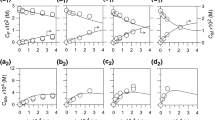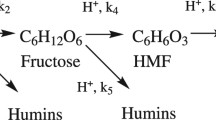Abstract
The competing acid catalyzed reactions of fumaric acid (F) isomerization to form maleic acid (Mx) (reaction R1), and the hydration of F to malic acid (M) (reaction R2) were investigated under microwave heating. The kinetic experiments were performed in a sealed microwave-irradiated batch reactor operated at pressures between 615 and 1715 kPa, in the temperature range from 433 to 478 K, and for reaction times up to 21,600 s. Hydrochloric acid at three different concentrations (C H = 0.65, 1.30 and 1.94 M) was used as the catalyst. The concentrations of F, Mx and M were periodically determined by HPLC analyses. The Arrhenius parameters for the forward rate constants of the reactions R1 and R2 were tuned on the experimental data of species concentrations (k 10 = 5.63 ± 0.04 M−1 s−1, E a1/R = 4837 ± 121 K, k 20 = (6.9 ± 0.3) × 107 M−2 s−1, E a2/R = 13,532 ± 212 K). The tuning procedure involved the Simplex method of optimization, and a kinetic model represented by a system of four ordinary differential equations from material balances on species F, Mx, M and HCl. The model was able to reproduce the variation in species concentrations with time for all experimental conditions investigated, just with a partial set of the currently obtained data used to adjust the model parameters (C H = 0.65 M and 1.94 M). The current results at C H of 1.30 M and analogous data from the literature under quite different reaction conditions (e.g.; C H = 0.97 M, non-isothermal reactor externally heated with glycerol) confirm the reliability of the modeling approach. The catalyst concentration had the expected significant effect on the reaction rates, but the influence of microwave irradiation on the kinetics of the conversion of F and on the selectivity of M was small.



Similar content being viewed by others
Abbreviations
- C F :
-
Concentration of fumaric acid (mol l−1)
- C F0 :
-
Initial concentration of fumaric acid (mol l−1)
- C H :
-
Concentration of hydrochloric acid (mol l−1)
- C M :
-
Concentration of malic acid (mol l−1)
- C Mx :
-
Concentration of maleic acid (mol l−1)
- C W :
-
Concentration of water (mol l−1)
- C WR :
-
Concentration of water in experiments reported in the literature (mol l−1)
- E a1 :
-
Tuned activation energy of the isomerization reaction (J kmol−1)
- E a2 :
-
Tuned activation energy of the hydration reaction (J kmol−1)
- f :
-
Objective function defined by Eq. 5
- k 1 :
-
Forward-rate constant of the isomerization reaction R1 (M−1 s−1)
- k 10 :
-
Tuned preexponential factor of the isomerization reaction R1 (M−1 s−1)
- K 1 :
-
Equilibrium constant for the isomerization reaction R1 at a temperature T
- k 2 :
-
Forward-rate constant of the hydration reaction R2 (M−2 s−1)
- k 20 :
-
Tuned preexponential factor of the hydration reaction R2 (M−2 s−1)
- k 2R :
-
Model parameter of Eq. 10
- K 2 :
-
Equilibrium constant for the hydration reaction R2 at a temperature T (M−1)
- K 2R :
-
Model parameter of Eq. 10
- P :
-
Reaction pressure (kPa)
- R :
-
Gas constant (J kmol−1 K−1)
- t :
-
Reaction time (s)
- t max :
-
Longest reaction time for a given experimental run (s)
- T :
-
Reaction temperature (K)
- x F :
-
Conversion of fumaric acid
References
Francis FJ (1999) Wiley encyclopedia of food science and technology. Wiley, Hoboken
Othmer K (2007) Encyclopedia of chemical technology. Wiley, Hoboken
Goldberg I, Williams R (1991) Biotechnology and food ingredients. Springer, New York
Garibay MG, Ramírez RQ, Canales ALM (2004) Biotecnología alimentaria. Limusa, Ciudad de México
Huang J, Huang L, Lin J et al (2010) Organic chemicals from bioprocesses in China. Adv Biochem Eng Biotechnol 122:43–71
Lee BH (2015) Fundamentals of food biotechnology. Wiley-Blackwell, Hoboken
Grand View Research (2015) Malic acid market analysis by application (Beverages, Confectionary & Food) and segment forecast to 2020. Grand View Research Inc, San Francisco
Rozelle LT, Alberty RA (1957) Kinetics of the acid catalysis of the hydration of fumaric acid to malic acid. J Phys Chem 61:1637–1640
Cullen Jr. MA, Ingleman M (1968) Purification of Malic Acid. Allied Chemical Corporation, US Patent 3391187
Weinrotter F, Schmidt A, Gauster W (1975) Process for the Production of Malic Acid. US Patent 3875222
Ortiz RWP, Benincá C, Cardozo-Filho L, Zanoelo EF (2017) High-pressure acid-catalyzed isomerization and hydration of fumaric acid in a homogeneous nonisothermal batch reactor. Ind Eng Chem Res 56:3873–3879
Zelle RM, Hulster E, Van Winden WA et al (2008) Malic acid production by Saccharomyces cerevisiae: engineering of pyruvate carboxylation, oxaloacetate reduction and malate export. Appl Environ Microb 74:2766–2777
Bond G, Moyes RB, Whan DA (1993) Recent applications of microwave heating in catalysis. Catal Today 11:427–437
Pizzetti M, Petricci E (2012) Heterogeneous catalysis under microwave heating. La Chimica & L’Industria 12:78–81
Durka T (2013) Microwave effects in heterogeneous catalysis: application to gas-solid reactions for hydrogen production. MSc dissertation, Warsaw University of Technology, Warsaw
Rosana MR, Hunt J, Ferrari A et al (2014) Microwave-specific acceleration of a Friedel-Crafts reaction: evidence for selective heating in homogeneous solution. J Org Chem 79:7437–7450
Priebe JM, Dall’Oglio EL, de Sousa PT Jr. et al (2016) Measurements of physicochemical properties during microwave-assisted acid-catalyzed transesterification reactions. Energy Fuels 30:3066–3077
Chun Y, He YG, Zhu JH (2001) Microwave-assisted synthesis of dimethyl carbonate. React Kinet Catal Lett 74:23–27
AOAC (1990) Food Compositions; Additives, Natural Contaminants (Official Method AOAC 986.13: quinic, malic, citric acid in cranberry juice cocktail and apple juice). AOAC, Arlington
Phillips MM, Case RJ, Rimmer CA et al (2010) Determination of organic acids in Vaccinium berry standard reference materials. Anal Bioanal Chem 398:425–434
Petzold LRA (1982) Description of DASSL: A Differential/Algebraic System Solver. Report SAND82-8637, Sandia, Albuquerque
Liu Y, Lawal A (2015) Kinetic study of autothermal reforming of glycerol in a dual layer monolith catalyst. Chem Eng Process 95:276–283
Goudarzi F, Izadbakhsh A (2017) Evaluation of K/SnO2 performance as a solid catalyst in the trans-esterification of a mixed plant oil. React Kinet Mech Catal 121:539–553
Umrigar V, Chakraborty M, Parikh PA (2017) Study of the reaction paths for cleaner production of nitrochlorobenzenes using microwaveirradiation. Chem Eng Res Des 117:369–375
Author information
Authors and Affiliations
Corresponding author
Electronic supplementary material
Below is the link to the electronic supplementary material.
Rights and permissions
About this article
Cite this article
Ortiz, R.W.P., de Jesús, B.G., Franceschi, E. et al. Microwave-assisted synthesis of malic acid involving hydrochloric acid as catalyst. Reac Kinet Mech Cat 122, 793–802 (2017). https://doi.org/10.1007/s11144-017-1287-7
Received:
Accepted:
Published:
Issue Date:
DOI: https://doi.org/10.1007/s11144-017-1287-7




